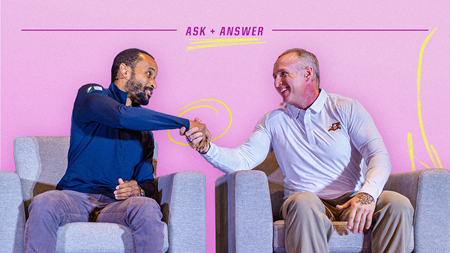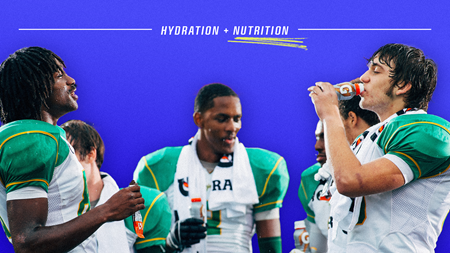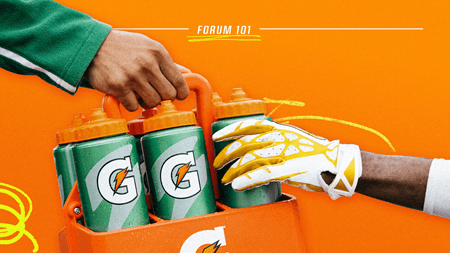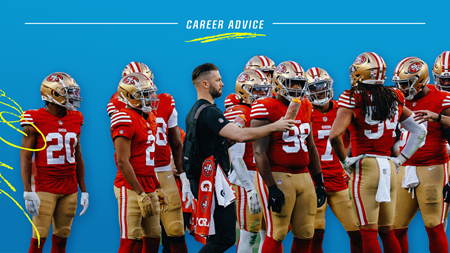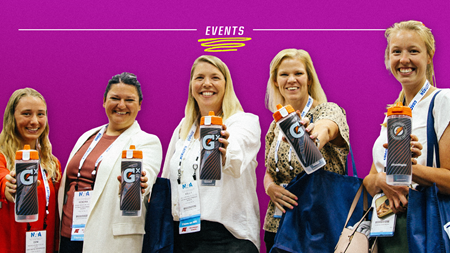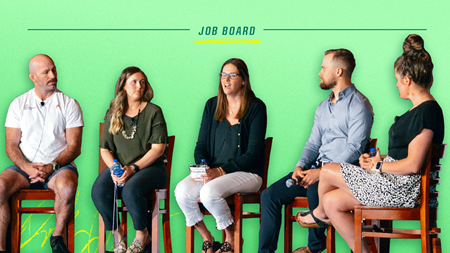

The first digital forum for sports practitioners like you
to connect, learn and grow across professions.
Gatorade Fieldhouse latest
Hydration and Fueling in Professional Rugby
Hi folks, I have been in Major League Rugby for 4 years now and just wanted to put a feeler out to see if anyone has some good suggestions for fueling and hydration strategies. Always looking to improve how we do things so any suggestions are welcome!
1 Comments
2 days ago

Introduce yourself!
Hey everyone! I am Brooks Leitner, MD, PhD currently working on a biotech start-up that develops novel omics-based biomarkers for healthspan and performance. I was previously a Kinesiology major at UMD, an ACSM-CPT, and conducted 3 years of research in the clinical metabolic research unit at the NIH (body composition, energy expenditure, CPETs, activity monitoring). I am also a member of the physician advisory committee of the Medical Fitness Association and work closely with clinicians, gym owners, and performance specialists who offer biomarker-driven health and performance protocols including exercise training and nutrition. Though I am currently replicating the Hickson 1977 J Appl VO2max training protocol (ouch), I typically do train CrossFit and Olympic Weightlifting. Favorite gatorade flavor has to be cool blue I would love to work with the pole vaulter Mondo Duplantis-- In that year I'm sure I'd witness at least one new world record
206 Comments
6 months ago

Access Gatorade Fieldhouse on the go.
Stay connected to the community from anywhere. Add the Gatorade Fieldhouse to your smartphone’s home screen for a faster, smoother experience, and receive real-time community notifications on the go. Adding Gatorade Fieldhouse to your home screen: iOS / Apple Devices Open Safari and visit Fieldhouse.Gatorade.com Tap the Share icon located bottom-center of the screen. Scroll down and select Add to Home Screen . Tap Add to confirm. That’s it! Now you’ll see the Gatorade Fieldhouse on your home screen like any other app. Android Devices Open Chrome and visit Fieldhouse.Gatorade.com Tap the Menu icon (three dots in the top-right corner). Select Add to Home Screen . Follow the prompt to confirm. That’s it! The Gatorade Fieldhouse will now appear as an app icon on your home screen. Enable Push Notifications Added the Gatorade Fieldhouse to your home screen? Turn on push notifications to stay connected. In order to do so you will need to: Tap the menu icon, then the bell icon. Choose " Gatorade Fieldhouse Notifications ". Scroll down and tap " Enable in browser ". *Note: If you're using iOS 15 or earlier and see the message: “ Push notifications not available in this browser ” — follow these steps to enable them: Open Settings Scroll to the bottom and tap Safari Scroll down and tap Advanced Tap Feature Flags Find Notifications and toggle it ON Once enabled, you’ll start receiving push notifications from the Gatorade Fieldhouse.
1 Comments
11 days ago
Calculating Energy Expenditure In Adolescent Athletes/ Calculating Required Intake for Specific Sports
Hi all, Trying to navigate some conversations with sports medicine over how to calculate energy needs in athletic adolescents. We go off of EER + Activity Level, as well as weight trends (following curve appropriately), and weight gain velocity (is client meet age appropriate growth markers). However, I've been getting asked why we do not use fat free mass composition to determine adolescent athlete needs- to which my response has been they are still growing/ developing, goal is to focus on meeting overall baseline needs for ADLS/ sports. I reinforce that if a pt is meeting his/her baseline needs of energy for ADLs/ sports, this will allow their body to build strength vs. deplete muscle. Any alternative methods for calculating energy needs in adolescent athletes? Methods for calculating estimated energy expenditure for specific activities? How have you navigated this rationale/ questions from medical providers/ families? Thanks y'all!
1 Comments
16 days ago

AMA with GSSI’s Eric Freese
On 6/24/2025 at 1:21 PM, randlest said: Dr. Freese, I hope this message finds you well. At Indiana University South Bend, we are in the early stages of developing a Sports Nutrition Lab to support better the health, performance, and education of our student-athletes. In my current administrative role, which I’ve held for the past five years, I’ve been working closely with Athletics and other campus partners to build out programming that integrates evidence-based practices with accessible tools. As we shape this initiative, I’m reaching out to learn more about current and emerging technologies that can effectively track dietary behaviors and support nutritional programming for collegiate athletes. Specifically, we’re interested in platforms or systems that can: Monitor and analyze eating patterns and nutrient intake. Provide individualized or team-level data insights. Integrate with wearable devices or physical performance metrics. Offer educational or behavioral nudges to support long-term adherence If you have any recommendations for technologies or systems, or if you would be open to a brief conversation, I would be grateful for your insights as we lay the foundation for a sustainable and impactful program. Thank you in advance for your time and expertise. Warm regards, Tony Randles, PhD, MPH Hi Tony, pleasure to meet you! The reality is, it’s a very segmented space, with different tools solving different parts of the athlete performance puzzle. There isn’t one all-in-one solution, but there are a few standout platforms designed specifically for collegiate athletics. For nutrition, ZoneIn and Notemeal (both now part of Teamworks) are leading options. They help athletes log meals, receive individualized guidance, and enable sports dietitians to scale support across an entire team. Both also integrate with Teamworks’ broader platform, making it easier to connect nutrition with training load, recovery, and readiness. There are a variety of data aggregator platforms in the market, each with unique capabilities, including Smartabase, Kitman Labs, and Teamworks, among others. If the goal is to tie everything together, from wearable data to performance metrics and behavioral nudges, one of those probably has the most integrated ecosystem that delivers an athlete-specific and integrated option out there right now. But depending on the need (e.g., food tracking, sleep, load management), different tools may be better suited for different programs. It’s an exciting space, but still evolving.
14 Comments
one month ago
Artificial Intelligence (AI)
Hey Marcella! Dr. Kyle Schneider and Dr. David Tomchuk just delivered a powerful session at NATA 2025 titled “Cracking the Code: A Clinician’s Guide to Using Artificial Intelligence in Athletic Training.” They outlined how athletic trainers can use AI tools—not as a replacement for clinical judgment or patient interaction—but to improve efficiency and ultimately enhance care. Here are a few practical ways they suggested athletic trainers can use AI right now: 1. Simplify SOAP Notes and Documentation Use AI platforms to speed up writing, proofreading, or summarizing injury documentation. According to the session, AI-assisted note-taking can reduce time spent on documentation and increase clarity for others reading your notes. Just remember: always review for accuracy—you're still the clinician. 2. Support Injury Evaluation and Rehab Planning AI can assist with building differential diagnoses for common injuries based on exam notes and symptoms. You can even create customized rehab programs, based on your facility's equipment and your athlete’s needs. The AI won't replace your eyes and hands—but it’s a strong assistant when you’re pressed for time. 3. Create Educational Materials Fast Need a heat illness infographic? A parent-friendly concussion handout? A Spanish-language return-to-play flyer? The presenters showed examples of how they prompted AI to generate these in minutes. They emphasized that while AI can draft visuals and summaries, you should always review and localize the content to meet your standards. 4. Streamline Admin Tasks This might have been the most practical part of the session. They showed how AI can help: Draft or update policies (e.g., EAPs, equipment checkout forms) Make those policies into fillable PDFs Assist in writing salary justifications, scheduling staff, or even drafting difficult emails 5. Analyze Injury and Workload Data If you’re collecting athlete data but not sure how to make sense of it, AI can help identify trends, summarize findings, and build visualizations—without needing a background in statistics. Upload your spreadsheet, delete PHI (this is very important!!), give AI some context, and let it help uncover actionable insights. Final Takeaways: You don’t need to be a tech expert to benefit from AI—start small. Be specific with your prompts and always double-check the output. Think of AI as your digital assistant—it can’t replace you, but it can help you focus more on your athletes and less on your paperwork. I'm looking forward to this thread continuing to evolve! Thank you for starting it!
4 Comments
3 months ago

